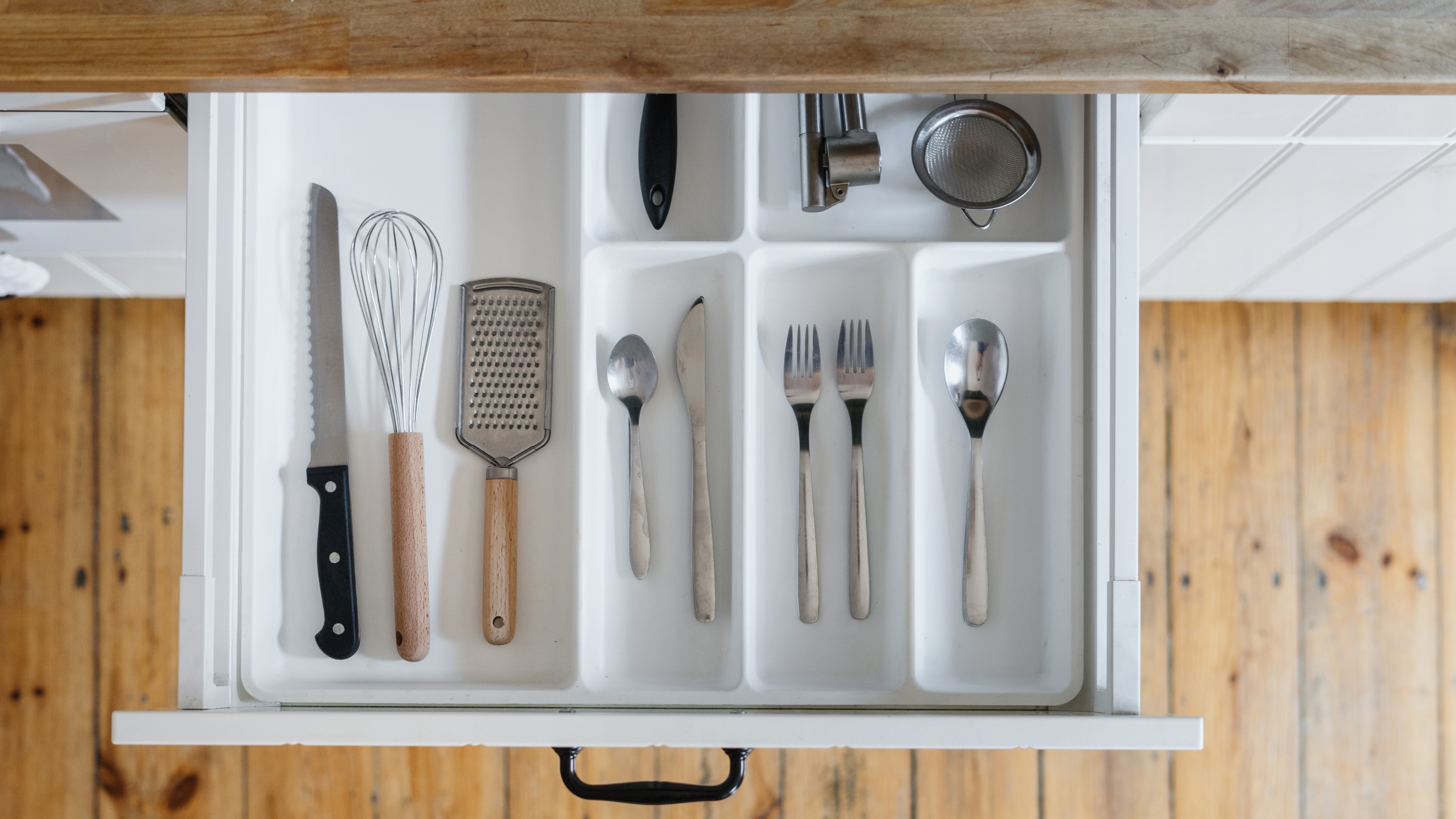

If you’re wondering how to declutter kitchen drawers, you’ve come to the right place. Keeping your kitchen drawers neat and ordered can be a little tricky, especially if you’re living in a more compact home with a small kitchen.
These six steps from our cleaning and organizing experts will guide you on how to declutter kitchen drawers, and most importantly, the best order to approach the task.
Knowing how to do this is an integral part of understanding how to organize a small kitchen and keep the space feeling neat and ordered. Our pro-approved six-step guide will have you drawers clutter free in no time.
How to declutter kitchen drawers
Believe it or not, with the right approach and a little guidance from our experts, decluttering kitchen drawers can be a total cinch, allowing you to organize a small kitchen quickly. Ready to learn how to declutter kitchen drawers? Let’s dive in.
1. Empty and assess
Hashi Mohamed, president of Ivy Cleans, says, “Begin by completely emptying the drawer. Lay everything on a clean surface, such as a table or countertop. This lets you see the full extent of what's inside and makes decluttering easier.”
When choosing what to keep and what to get rid of, Hashi recommends applying the Marie Kondo method of only keeping items that spark joy, or serve a purpose for you.
Going forward, Hashi says, “Implement a one-in, one-out rule for your kitchen drawers. For every new item you add, remove an old one to maintain a clutter-free and organized space.”

Hashi Mohamed is the president of Ivy Cleans, a premier cleaning and lifestyle solutions company based in Minneapolis, Minnesota. Specializing in cleaning, organizing, and promoting a holistic lifestyle, he is passionate about transforming spaces into clean, organized, and vibrant environments.
2. Group items into categories
Hashi says, “Group similar items together into categories. For example, create categories like utensils, cooking tools, baking supplies, or miscellaneous items. This helps you identify duplicates and streamline your drawer's contents.”
Eileen Roth, organizing expert at Everything in its Place®, and author of Organizing For Dummies®, says, “The best way to declutter kitchen drawers is to put like with like. So silverware would be in one drawer, while serving pieces would be in another drawer and slicing or cutting knives would be in another drawer, as well as cooking pieces.
“Other small kitchen items for baking (scrapers, small non-glass measuring cups) might be in another drawer while other larger items like juicers, apple slicers, egg slicers, fondue forks, nut crackers, ice cream and scoops would be in one or two other drawers.”
Amy Trager, Certified Professional Organizer, says, “Pull everything out of the drawers and create categories: everyday silverware, cooking utensils, serving utensils, and so on. Once everything is categorized it's much easier to assess not only the volume of each category but if everything in each group should be kept.”

Eileen Roth is an organizing expert, speaker, and author of Organizing For Dummies®. She named her company Everything in its Place® because she believes you truly can put everything in its place.

Amy Trager is a Certified Professional Organizer® based in Chicago. Certified in 2007, she is also a NAPO member. Since 2006, Amy has been guiding individuals through the stress of their stuff by creating calm, enjoyable spaces.
3. Clean each drawer
Once each kitchen drawer has been emptied, it’s worth taking the time to give the drawer a good clean. The chances are the bottom of the drawer is full of dust, crumbs, and other debris.
To remove crumbs and other debris from the base of the drawer, use the best handheld vacuum cleaner (such as this cordless Black + Decker mini vacuum from Amazon, has over 20,000 five-star reviews) to get into all the nooks and crannies, sucking up any dust, crumbs or other debris.
Once the drawer has been vacuumed out, the next step is to wipe the base and sides of the drawer clean (these Clorox cleaning wipes from Amazon would work well), before using a sheet of paper towel (this Bounty paper towel from Amazon should do the trick) to dry out the drawer.
4. Use drawer liners
Draw liners are a great tool for both keeping kitchen drawers clean, and preventing utensils from slipping about and getting mixed up
Hashi says, “Add non-slip drawer liners to keep items from sliding around and protect the drawer's interior from scratches and stains.”
You can either choose to use silicone non-slip drawer liners (like this highly-rated cut-to-size roll of drawer liner from Amazon) or paper drawer liners (like this paper drawer liner from Amazon that comes in lots of pretty colors and designs).
5. Add drawer dividers
Feel like your drawers always end up with the items getting mixed up in a mess? Then drawer dividers are sure to be a complete godsend.
Hashi says, “Use drawer dividers (like these adjustable bamboo drawer dividers from Amazon) or organizers to create separate compartments (like these compartment-creating drawer organizers from Amazon) for different categories of items. This prevents utensils and tools from becoming jumbled and makes it easier to find what you need.”
Alternatively, Hashi recommends using deep drawer inserts (like these deep drawer inserts from Amazon) and says, “Consider using custom deep drawer inserts with multiple compartments to maximize storage space and keep items neatly organized if you have deep drawers.”
For drawers that aren’t a normal width or shape, it’s smart to invest in expandable utensils trays (like this expandable utensils tray from Amazon) you can adjust to fit the width and length of the drawers. These trays are also great for accommodating utensils of various shapes and sizes.
6. Invest in cutlery and utensil storage
If there’s one drawer in your kitchen that’s going to end up in a mess more quickly, it’s going to be the cutlery and utensil drawer. This is why having adequate storage in place is so important for keeping these drawers neat and ordered.
Eileen says, “When it comes to cutlery organizers (such as this Joseph Joseph cutlery organizer from Amazon), I prefer the ones with rectangular slots. That way, you can put small forks opposite small spoons and keep them in one slot. Long forks can then be opposite of large spoons and knives take a slot for themselves.
“This not only saves space, but it also helps having them opposite to keep them from falling in their slot. Any other sections can then be used for serving pieces or whatever else you need while preparing meals, like butter knives or kids' cutlery,”
If you’re living in a small kitchen that has more compact drawers, it’s best to opt for space-saving cutlery and utensil holders (this this Joseph Joseph space-saving cutlery organizer from Amazon has over 70,000 five-star reviews from impressed shoppers).
FAQs
How can you ensure your kitchen drawers stay clutter-free?
Hashi says, “Make it a habit to review your kitchen drawer contents regularly, ideally every few months. This helps prevent clutter from accumulating and ensures your drawers stay organized over time.”
Hashi advises, “Following these tips and hacks, you can effectively declutter your kitchen drawers, create organized compartments for your utensils and tools, and maintain an efficient and tidy kitchen space.”
Now you know how to declutter kitchen drawers, expand your scope and declutter your whole kitchen.
Join our newsletter
Get small space home decor ideas, celeb inspiration, DIY tips and more, straight to your inbox!

Hi! I’m Beth Mahoney and I’m a former staff writer at Real Homes. I’ve been a journalist for the national press for the past six years, specializing in commerce and trends-related lifestyle articles, from product reviews and listicles to guides and features. With an eye for pretty things (think: quirky wall prints, scalloped edge furniture, and decadent-looking tableware) but a limited budget, I love nothing more than a bargain buy.